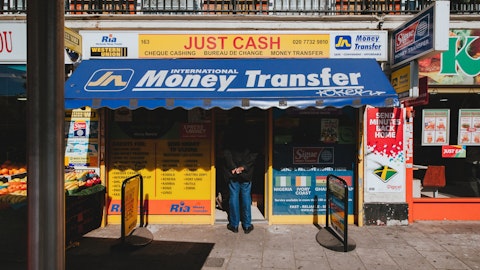Jason Kupferberg: Thanks, guys. I wanted to come back to the vertical point of sale in Square. You had the gross profit of 29% there. Is that growth rate sustainable over the next few quarters? And I’m curious what percent of Square’s total gross profit is now coming from vertical point of sale? And then separately, if you could just make a quick comment on what you’re expecting for stock-based comp expense both this year and next year? Thank you.
Amrita Ahuja: So, Jason, I can start. So, in the third quarter, yes, we had a strong growth in our vertical point of sale and developer solutions, where gross profit from our vertical point of sale products across retail, restaurants, and appointments was up 29% year-over-year, and gross profit growth from our developer tools also outpaced overall Square gross profit growth. As we said last quarter, each of our vertical point of sale products delivered gross profit of over $100 million on an annualized basis during the third quarter as well. And there’ll be key pieces of how we optimize our go-to-market strategy, improving onboarding flows and experimenting with new channels. I won’t give you a specific number for vertical point of sale going forward, but we did note that we expect Square gross profit growth from the Q4 perspective to improve relative to Q3, partly because of the more favorable comparisons as well as the full quarter of a pricing movement that we take on — we took on Square Invoices during the third quarter.
And your second question was related to stock-based compensation?
Jason Kupferberg: Right, for 2023 and 2024, just in the context of the AOI targets?
Amrita Ahuja: Sure. So, stock-based compensation in the fourth quarter, we expect to be relatively flat relative — on an absolute dollar basis relative to the third quarter. And as I said on the call earlier, we expect to drive meaningful leverage on SBC over time starting in 2024. And here we’d measure it as stock-based compensation as a percentage of gross profit as we implement the absolute number cap on the number of people that we have at the company and look to drive operational leverage and efficiencies across our business. This is a key focus area for us. Obviously, SBC is an important tool for us in how employees, our shareholders align our incentives as owners of the business, but it’s one that we’re very mindful of and have deliberately included in our financial targets and adjusted operating income to be measuring and watchful of the amount of dilution.
That’s also part of the reason that we’ve got our $1 billion buyback that we’ve announced today is an intention to offset a portion of dilution moving forward.
Jason Kupferberg: Thanks, Amrita.
Operator: We’ll take our next question from Pete Christensen with Citi.
Pete Christensen: Good evening. Thanks for the question. Jack, I wanted to dig a little bit into the go-to-market on the Square side. Connecting a few dots from earlier questions, conversations, sounds like Square may be more interested in participating with the [ISO] (ph) channel to distribute Square products. Is that something on the roadmap? Is that something where you’ve experimented before? Do you believe that Square needs to embrace the ISO channel more to scale against competitors? Thank you.
Jack Dorsey: We have experimented with it before from a financial partnership perspective. Specifically, we had a partnership with JPMorgan Chase and gave out score readers at all of their branches as a distribution point. Not [indiscernible]. I think the most important thing is like we need to experiment more and we need to experiment with different models. I think the answer is not going to be generalized, it’s going to be specific to the vertical. This looks different in terms of distribution for a restaurant than it does for services and beauty and then that’s completely different from retail. So, I think the most important point to take away is like we want to be open to a lot more experimentation that’s on a smaller scale for a bit of time so that we can see what’s working and then invest in a much heavier way.
We are looking more deeply at just some immediate experiments such as contracts, which we’re seeing some early success from some local campaigns, more partnerships and specifically referrals, which we think there’s a lot to it. It kind of hearkens back to our earliest day in terms of how Square spread, which was entirely by word of mouth referrals, helps push that even more. And then, just making sure that we’re focused on the experience the sellers have when they get in to the service or when they go to our website. So those I think are the biggest drivers.
Pete Christensen: Thank you. That’s helpful. A lot of good stuff here. Thank you.
Jack Dorsey: Thank you.
Operator: And we’ll take one more question. And we’ll take that question from Andrew Jeffrey with Truist Securities.
Andrew Jeffrey: Thanks. I appreciate you sneaking me in here at the end. Amrita, the Cash App monetization framework has always been really helpful. Could you unpack a little bit sources of monetization within Cash App? I’m thinking specifically about Instant Deposit versus Interchange, and how that’s changed over time? And how you think about the Instant Deposit product in particular in a real-time payments world?
Amrita Ahuja: Sure. Thanks for the question, Andrew. We’ve had a growing set of products across Cash App, and some of which are free and some of which are monetized, and have grown the pace of monetization of some of the products outside of Instant Deposit even faster than Instant Deposit. So, the mix of the business relying on Instant Deposit has declined over time, despite the fact that that continues to be a growing product for us and has unique use cases around customer utility. Of course, our focus is as much as possible delivering value within our ecosystem across a number of products. And that’s where you’ve seen the strong growth of things like Cash App Card with 22 million, 40% attached to our 55 million monthly active base, and where we’ve seen strong growth from per-active spend perspective, which continues into the third quarter with growth on a year-over-year basis there.





